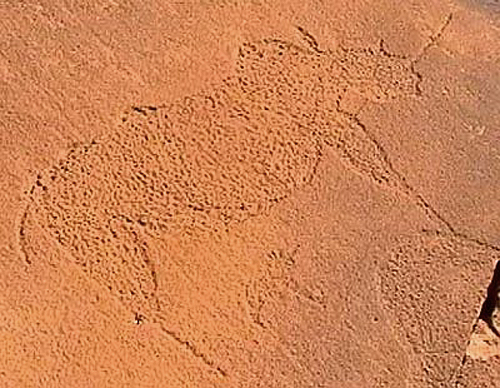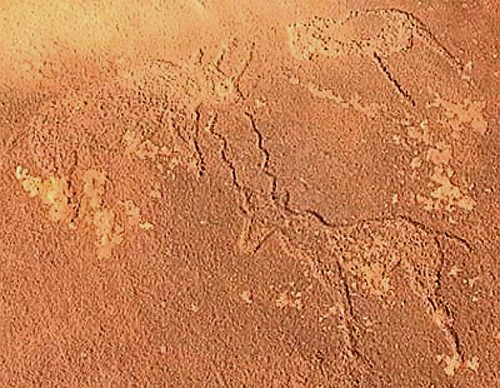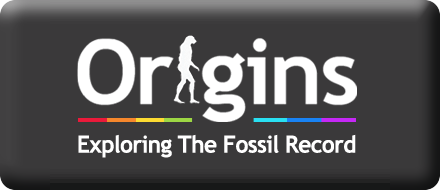 |
 |
APPENDIX 2 - TWYFELFONTEIN SITE REPORT BY SVEN OUZMAN |
5/18 |
Site N on Scherz’s Map
S 20° 34’ 45’’ / E 14° 22’ 23”
Site Description
This site has both Bushman rock paintings and Bushman rock engravings. The site takes the form of a cluster of large rock blocks at the foot of the valley wall, approximately 600m south west of Site 4 – Die sieben Tafeln outlier. The site is in a natural concavity on the valley profile on the 600m contour. The largest, most squat rock block forms a good overhang shelter 10m long, 2m deep and up to 2m high, facing south-east with good views to east and south but with no direct sight line to the main site complex. The mouth of the overhang is defined by a number of small rock blocks that act as a sand/deposit trap. This rock block abuts with another higher block to the west and forms a passage between the two rock blocks and, indeed, these two rock blocks can be said to make up two lobes of a single overhang. Behind and to the north and east of these blocks is a very large angled block that also bears engravings.
Associated Archaeology
This site was excavated by Dr. Eric Wendt and the original excavation, spoil heap and sieve stand are still visible. There is up to 0.6m of reasonably fine, softish and ashy archaeological deposit here. The site was obviously a favoured habitation place for the Bushmen in times past and there is a rich and extensive surface scatter of quartzite and hornfels stone tools of every description (see ‘Associated Archaeology’ of Site 1), ostrich eggshell fragments and beads, charcoal, bone and so forth. There is a possible lower grinding patch on one of the rock blocks at the mouth to the overhang.
Description of the Hasenblock’s rock art
There are three concentrations of Bushman rock engravings, numbering about 40 images and one concentration of about 35 Bushman rock paintings.
Bushman rock paintings in Overhang site: The large overhang and living site bears on its back wall the remains of what must have been an densely and extensively painted frieze, which is now visible only in two areas –one at each lobe of the shelter. The largest cluster in the main lobe is 1.5m x 0.9m and is located immediately above the excavation. There are at least 18 human figures painted in red, light red, dark red and black paint. These human figures adopt a variety of postures such as running, running and looking over a shoulder, bending forward at the waist, sitting, standing, holding hand-to-nose. There are also two paired and rayed circle motifs that may represent the work of Khoekhoen herder peoples. The second area of painting in the site’s western lobe has 7 human figures painted in red and depicted in an interlocked striding posture (
Figure 72).
Engravings in and on top of Overhang passage: In between the overhang’s western and eastern lobes is a natural passage. On the passage’s steeply sloping (50°) eastern side there are engraved an oryx, a 270mm x 210mm zebra in fine partial pecked-infill, a wonderfully wiggly horned kudu bull that measures 500mm x 300mm, located near the edge of the rock block (
Figure 73). The kudu's legs are rather giraffe-like and this engraving is also a partial pecked-infill technique. Higher up on the rock there is an outline and partial pecked-infill giraffe associated with a pecked-infill animal that has lost its head. Highest up is a rough animal made in a scratched technique. On the lobes western and steeper wall there are two deeply pecked outline and lighter infill giraffe, one of which has dimensions of 620mm x 420mm. There is a smaller oryx and a larger animal here. For whom were these animal engravings meant to be seen? They are only visible when one is in the narrow passageway. On the western side of the western lobe there is a fine pecked-infill animal with long neck and no head.
Top of smaller lobe: On top of the smaller lobe (access the top by climbing up the western side of the rock block) is an image cluster of 1.4m x 1m on a concave and horizontal surface near the eastern edge of the rock block. There are two giraffe – one in pecked-infill and one in rough pecked-outline and rough pecked-infill. The legs end in spoor-hooves, which are depicted in twisted perspective. In pecked-infill there is a collection of a rhino, an ostrich, an oryx and a zebra with a 3-pronged head. There is also a possible human figure and a partial pecked-infill engraving of a rabbit-like animal, from which the site derives its name. In pecked-infill there is an equid and in pecked-outline there is an antelope. Lower down there is another, rather amorphous animal and on the western side there is a rough pecked-outline giraffe-like animal. One isolated animal. Good view from this site, but impossible to see unless one climbs up onto the top of the rock block.
Figure 75
Click for Enlargement
Figure 74
Click for Enlargement
Sloping slab behind overhang: Behind and about 60m north-east of the overhang site on a 40° sloping and very flat rock block of big size (approximately 4m x 3m) with three fracture lines through it there are 23 engraved animals in pecked-outline, pecked-infill and partial pecked-infill techniques. Though the peck marks are quite large, they are finely done and the effect is of a fine-pecked engraving. There is a 1050mm x 900mm elephant and white rhino of similar size (
Figure 75). There are at least 4 kudu, with the uppermost two having superb wiggly horns (
Figure 74). There is an ostrich and a giraffe. The legs of one equid end in spoor-like hooves in twisted perspective. There are six other rhino and an elephant, two other equids and a jackal-like animal. The engraved expanse is about 3.5m x 2.5m.
Outlier rock: To the east of the overhang site, lower down and about 80m away right above the hiking trail is an angular rock block of medium size on which are engraved two giraffe in pecked-infill and in partial pecked-infill. The one giraffe has dimensions of 43cm x 36cm.
Threat(s) to site: The excavation at the overhang site has not been backfilled and this should be done by lining the excavation hole with geotex or something similar and filling it up with material from the spoil heap, which should be re-sieved in order to determine if any artefacts were missed. The sieve stand should be removed. The paintings are naturally disappearing because of the flaking Etjo sandstone sheets. The Sloping Slab site is on a very thin and already fractured expanse of Etjo sandstone and will be destroyed if people walk on this surface. Even if left as they are, the fractured slabs will eventually slide off the heart rock and therefore need to be stabilised. The outlier rock has an algal or lichen growth over it from water that flows directly onto the engravings during wet times.
→
A Survey into the Relationship between
Animal-Engravings & Cupules
→
The Rock Art of Twyfelfontein
→
The Rock Art of Namibia
→
The African Rock Art Archive
→
Bradshaw Foundation
Like us on Facebook & Follow us on Twitter to receive news & updates:










